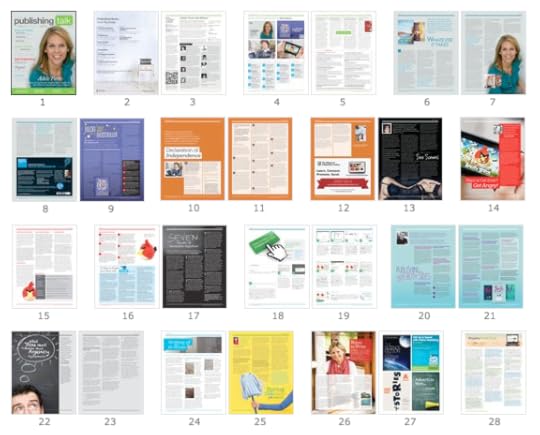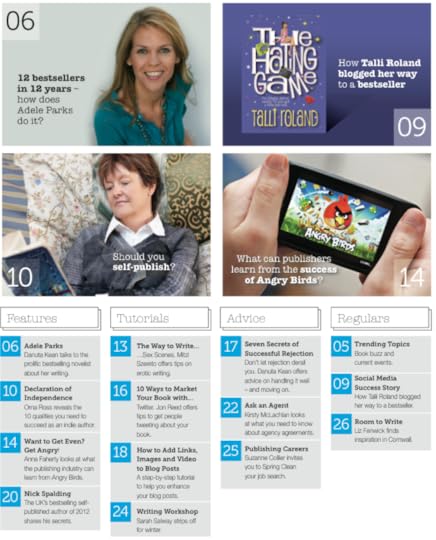Jon Reed's Blog, page 15
April 3, 2013
Bologna Children’s Book Fair 2013

The rights-selling frenzy at Bologna Children’s Book Fair starts on a Monday, and as ever, the Sunday afternoon flight from London was full of children’s book types eager to sell or buy the Next Big Thing – publishers, agents and literary scouts, along with a small gaggle of authors and illustrators. Airport delays meant many sadly missed out on the Random House party in the Royal Carlton Hotel, which usually kicks the Fair off in style.
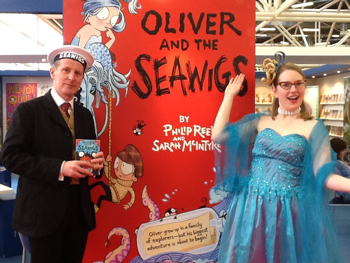 Despite the unusually cold, damp weather, the Monday halls were buzzy and busy from the start, especially over at the OUP stand, where a behatted Philip Reeve and a bewigged and ballgowned Sarah McIntyre drew crowds of photographers as they decorated the stand in fine style, surrounded by pen-shaking minions. Publisher Liz Cross expressed excitement over their upcoming joint venture Oliver and the Seawigs, and was also upbeat about Wendy Meddour’s Wendy Quill is a Crocodile’s Bottom, illustrated by the author’s 12 year-old daughter, Mina May.
Despite the unusually cold, damp weather, the Monday halls were buzzy and busy from the start, especially over at the OUP stand, where a behatted Philip Reeve and a bewigged and ballgowned Sarah McIntyre drew crowds of photographers as they decorated the stand in fine style, surrounded by pen-shaking minions. Publisher Liz Cross expressed excitement over their upcoming joint venture Oliver and the Seawigs, and was also upbeat about Wendy Meddour’s Wendy Quill is a Crocodile’s Bottom, illustrated by the author’s 12 year-old daughter, Mina May.
The many British publishing stands in Halls 25 and 26 had a steady flow of half-hourly appointments on all three days – but Puffin were off to an early good start and keen to talk up their pre-Bologna purchase Half Bad by Sally Green (with a US auction and multiple offers in the French and German markets being tied up at the time of writing), which is Editorial Director Ben Horslen’s first acquisition since moving from Random House earlier in March. Harper Collins flagged up ex-MacMillan publisher’s brand-new Mirror Chronicles and spoken-word poet Steven Camden’s debut novel Tape as ones to watch, while Templar Books were seeing the Big Picture with their new illustrated imprint launching in September with a very international feel.
Digital is as big as ever, with brands and interactivity taking top spot. Talks in the Digital Cafe post-TOC were well-attended, particularly Nosy Crow MD Kate Wilson’s session with The Guardian’s Julia Eccleshare. Ironically, the lack of internet connection for tweeting purposes (and appalling wifi coverage in general throughout the Fair) was frustrating for many in getting the word out to a wider audience. Wilson maintains that the digital choices already made at Nosy Crow are vindicated by what she heard at Sunday’s TOC conference. Designing different content for the screen is key. “Print remains an important way of delivering books…but there’s no point in squashing a picture book onto a phone.”
In a pleasing close to the first day of the fiftieth Fair, popular publisher Klaus Flugge of Andersen Press was given honorary citizenship by the president of the Comune de Bologna. Flugge has attended all fifty Fairs, and was acknowledged for his “valuable activity and remarkable commitment in the field of children’s books.”
Tuesday brought even more visitors to swell the aisles. Spotted in passing were illustrator Babette Cole, Nicolette Jones of the Sunday Times, David Maybury of Inis Magazine, Irish Laureate na n-Og, Niamh Sharkey, illustrator Axel Scheffler and children’s literacy consultant, Wendy Cooling. The big excitement of the day was news from Catherine Clarke of Felicity Bryan about debut author Clare Furniss, who she first met four years ago at a SCBWI conference. After a frantic seven-way battle between publishers, Clarke finally sold Furniss’s The Year of the Rat to Ingrid Selberg of Simon and Schuster, and there are also deals with Bompiani in Italy and Hanser in Germany, as well as other foreign offers on the table.
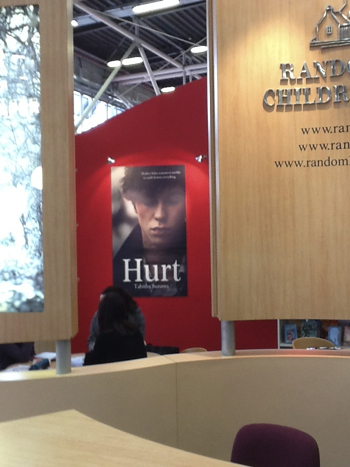 Random House picture book Publisher, Fiona MacMillan was bubbling with enthusiasm over Shirley Hughes and Clara Vulliamy’s mother/daughter collaboration on the Dixie O’Day series, which has a delightfully retro feel – fitting in nicely with the current 1950′s zeitgeist picked up on by popstar fashion icons Paloma Faith and Lana del Rey. There are three titles already under contract, and MacMillan is negotiating for three more. The book will be “a beautiful and precious object” in the hardback edition, and editions have already sold to Japan and the USA. MacMillan also talked up Hughes’s forthcoming Alfie’s Christmas along with breaking news of an interactive permanent placement at the Natural History Museum for Paul Strickland’s classic Dinosaur Roar to celebrate its twentieth anniversary along with associated e-pub and enhanced editions.
Random House picture book Publisher, Fiona MacMillan was bubbling with enthusiasm over Shirley Hughes and Clara Vulliamy’s mother/daughter collaboration on the Dixie O’Day series, which has a delightfully retro feel – fitting in nicely with the current 1950′s zeitgeist picked up on by popstar fashion icons Paloma Faith and Lana del Rey. There are three titles already under contract, and MacMillan is negotiating for three more. The book will be “a beautiful and precious object” in the hardback edition, and editions have already sold to Japan and the USA. MacMillan also talked up Hughes’s forthcoming Alfie’s Christmas along with breaking news of an interactive permanent placement at the Natural History Museum for Paul Strickland’s classic Dinosaur Roar to celebrate its twentieth anniversary along with associated e-pub and enhanced editions.
Edinburgh publishers Barrington Stoke have brought books for dyslexic kids into the twenty-first century mainstream with buoyant sales and big names. News that their Little Gems series has sold 40,000 copies in its first three months alone, including to non-trade outlets such as Sainsburys and WH Smith mean their high-end production values and high-class author strategy are clearly paying off. Forthcoming hi-tech jackets will get them noticed even more, as will a new picture book list for 3-5′s launching in spring 2014 with titles from Michael Morpurgo, Eleanor Updale, and one more Mega Big Name who will be announced soon. These will be all about layout, accessibility and helping parents who may themselves have reading difficulties to share with their kids.
The prestigious Astrid Lingren Prize (worth $700,000) was won by Argentinian illustrator, writer and cartoonist Isol, and the announcement was live-streamed from Lindgren’s home town of Vimmerby in Sweden. Judges praised Isol’s “energy and explosive emotions” as well as her “liberating humour and levity”.
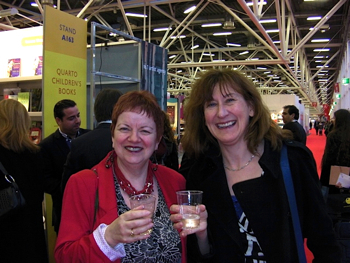 Tuesday night was all about the parties, with Egmont in a nightclub, Usborne offering prosecco and bookish chat, while the Children’s Books Ireland stand preferred whisky, smoked salmon, cheese with Guinness and an excellent art exhibition (including work by P.J Lynch, Oisín McGann and Donough O’Malley) curated by Niamh Sharkey, Laureate na nOg. Irish publishing hearts were definitely in festive mood, especially at Futa Fata where a number of interesting deals are in progress. Frances Lincoln Books hosted a launch for Mary Hoffman and Ros Asquith’s The Big Book of Feelings, where publishers from nine countries toasted the book’s success in bagging no less than fourteen co-editions so far. The Faroese publisher Niels Jákup Thómsen, Managing Director of Bókadeildin shared news that a copy of Hoffman and Asquith’s previous book, The Big Book of Families had been given to every member of the Faroese Parliament, as an encouragement to support the cause of gay marriage.
Tuesday night was all about the parties, with Egmont in a nightclub, Usborne offering prosecco and bookish chat, while the Children’s Books Ireland stand preferred whisky, smoked salmon, cheese with Guinness and an excellent art exhibition (including work by P.J Lynch, Oisín McGann and Donough O’Malley) curated by Niamh Sharkey, Laureate na nOg. Irish publishing hearts were definitely in festive mood, especially at Futa Fata where a number of interesting deals are in progress. Frances Lincoln Books hosted a launch for Mary Hoffman and Ros Asquith’s The Big Book of Feelings, where publishers from nine countries toasted the book’s success in bagging no less than fourteen co-editions so far. The Faroese publisher Niels Jákup Thómsen, Managing Director of Bókadeildin shared news that a copy of Hoffman and Asquith’s previous book, The Big Book of Families had been given to every member of the Faroese Parliament, as an encouragement to support the cause of gay marriage.
Wednesday dawned bright and sunny, with the gelato stand by the Literary Agents’ Centre doing a roaring trade under the up escalator. It was just as busy at the top, where heads were bent over tables, examining picture books and brokering potential deals.
Both agents and publishers were generally upbeat across the board, talking of a strong emerging market in Turkey, and mentioning crime, standalone middle grade fiction, brand building and humour as trends publishers are currently interested in, with the picture book side also making a strong showing. There was a more obvious US presence than in previous years, which many found encouraging. As at recent fairs, news of more done deals and acquisitions will emerge in the weeks after the Fair, but in general, Bologna 2013 was seen as creative and busy, with some cautious green shoots of post-recession revival poking their heads above the publishing parapet.
All images © Lucy Coats


February 15, 2013
Publishing Talk Magazine issue 4, Mar-Apr 2013 – Romantic Fiction
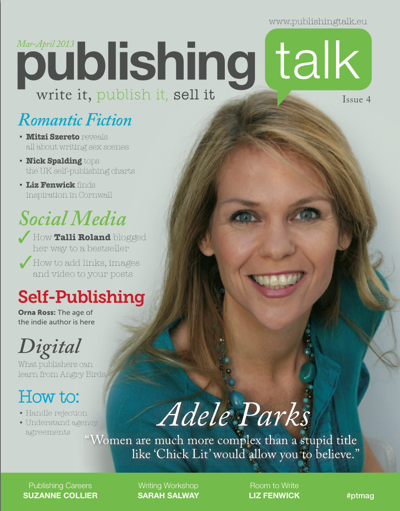 Romantic fiction authors share their tips in issue 4 – available now in print or digital.
Romantic fiction authors share their tips in issue 4 – available now in print or digital.
Want to know how to blog your way to a bestseller, write sex scenes, pick your way through an agency agreement or what qualities you need to be an indie author?
Adele Parks, Danuta Kean, Nick Spalding, Talli Roland, Liz Fenwick, Mitzi Szereto and Orna Ross are among our glittering line-up of bestselling authors and industry experts offering their insider advice in this bumper issue.
There’s also a feature from Anna Faherty on what publishers can learn from the success of Angry Birds, a writing workshop from Sarah Salway, careers advice from Suzanne Collier, and Kirsty McLachlan on what you need to know about agency agreements. Plus a step-by-step tutorial on adding links, images and video to your blog posts, and 10 ways to market your book with Twitter.
What we’re talking about in this issue
Buy now
 Publishing Talk Magazine is now available in three digital formats from this very website – PDF, mobi (Kindle) and ePUB – plus in print from MagCloud if you prefer. Or join the mailing list to get some free sample pages.
Publishing Talk Magazine is now available in three digital formats from this very website – PDF, mobi (Kindle) and ePUB – plus in print from MagCloud if you prefer. Or join the mailing list to get some free sample pages.
PLUS, for a limited time, you can buy issues 1-4 for £7 – a saving of £5. That’s all four issues in three formats – 96pp, 56,000 words, 12 digital files and one single, easy payment.
Issue 4 is available now:


February 11, 2013
No Time for Print: Why the future of ideas is electronic

In today’s time-poor attention economy, social media and ebooks have replaced print as the channel for radical ideas. Is print really on the way out? And should we be worried?
It has been almost 250 years since Common Sense was written by Thomas Paine and utilized to rally the colonies toward the American Revolution. It’s only been 150 years since Uncle Tom’s Cabin by Harriet Beecher Stowe stoked the fires of a different war, this time the American Civil War, and not even 60 years have passed since the first publishing of Anne Frank’s Diary, shedding light on the horrors of WWII. These pieces of writing have moved people in ways that radically changed people’s perceptions as well as the world that those people and ourselves live in.
Fast-forward to the present day and ask yourself what you have read recently. Billboards on the way to work, traffic signs, advertisements on your favorite websites, this article, the directions on top of the cup of noodles; and that’s generally what most people do read. Blurbs. Snippets. If Oprah’s Book Club or the NY Times recommends it, maybe you’ll get people to read a book—but then how many people do you know that would rather just wait for the book to be made into a movie? Perhaps I’m being too critical of the society that I live in, and that is not my purpose, but with interest in literature waning, replaced by movies, video games, and other forms of direct media, I have to wonder what the future holds for books.
e-Everything
With advancements in technology, companies like Amazon, Apple, and Barnes & Noble have cashed in on the latest e-book trend. Last year Amazon reported that they sold more ebooks than they did paperbacks. Apps like OverDrive allow people to rent ebooks from their local libraries. The Audible app delivers audiobooks on demand to thousands of users all over the world. Last year, Fifty Shades of Grey became the first ebook to sell 1 million copies in history, and was actually originally a piece of Twilight fan fiction that was published on the Internet. Technology is allowing us to experience writing in a cornucopia of unconventional ways that seem to expand every month.
It may have been this accessibility that killed the conventional bookstore. With the closure of the final Borders bookstore in September 2011, the world of literature was ushered into a new era. It would be incorrect of me to say that people don’t read anymore—they just seem less likely to read things actually printed on paper.
Blogs
Popular books and ebooks published in the last couple of years have included fantasy storytelling, female erotica, weight-loss and dieting books, self-help books and cookbooks. Interestingly enough, there has not been a popular literary outcry in the U.S. with major results in the last decade, despite war, unemployment, and economic crisis. The Wonderful Wizard of Oz and The Octopus are two novels that were written in 1900 and 1901 respectively about the infamous robber barons and the railroad monopoly, and in this time we saw political and social activism sprout up around these books. Books don’t tend to do that anymore. Blogs do.
Occupy Wall Street, which gave rise to subsequent Occupy movements all over the world, was originally organized through a blog, and relied heavily on social media outlets for further organization. The Arab Spring uprisings have employed blogs and social media to achieve their ends. While books used to be the primary mode of communication of ideas, it seems that the Internet may be taking over as the fire-starter for impassioned movements.
TLDNR (Too Long Did Not Read)
So what do we read anymore? A lot of people skip the article in favor of the headline, skim text for keywords, or refer to the video report instead of the article. Sparknotes offers comprehensive summaries of classroom books so that students don’t have to read them. Tweets only allow for 140 characters per post, and Facebook updates that are longer than a paragraph are a rarity. The knack for brevity that we have developed in our reading/writing habits is apparent everywhere.
Do people feel like they don’t have the time to read any more in such a fast-paced world? Some people feel like they don’t, and others feel like it is a waste of their time. Some would rather spend that time in front of more frenetic forms of media, such as video games, TV shows, and movies. Attention spans don’t seem like they will allow for books to survive.
The Future
Ray Kurzweil, author of The Singularity is Near, has predicted that within a matter of decades, machines will become so integrated in not only the human environment, but within the human anatomy, that you will be able to send emails by thought, and eventually upload information into your conscious mind through flash drives. I’m not saying that I agree with Kurzweil, necessarily, but I do think that certain possibilities have to be considered in regards to the future of books.
Books are being chalked up as vessels of information, and what the technological age has done for information involves efficiency. Information is becoming more and more streamlined, and people are looking to get the most information for the least effort and in the shortest amount of time. Most people can watch a movie more quickly than they can read a book, which explains why many people do just that. Your RSS feed gives you the gist of an article in a fraction of the time it would take to read the article itself. What will happen when a person can upload and understand a book’s text within a matter of minutes?
It is a bold statement, but I think that the conventional paper book is in danger of extinction. Ebooks, blogs, and truncated information from the cyber-frontier are already doing their part to ensure the death of the paper book. They are transforming not only our mode of literary absorption, but the content of that literature.
I used to be afraid that I would live in a dystopian future reminiscent of Bradbury’s Fahrenheit 451, where people feared and burned books at the behest of the government. I’m not afraid of that any more; I’m afraid that there won’t be any books left in our future to burn.


January 30, 2013
What agents really want
By Danuta Kean at danutakean.com:
Yesterday I taught my first Guardian Masterclass of the year on how to pitch your book. The next is on 23rd February (click Guardian Masterclass for details). A question students always ask is: what exactly do agents want? It is easier to answer than you might think.
Of course everyone in publishing would say ‘voice’, by which they mean the character and personality of the writing. Agents want a voice that is unique, fresh and engaging. If you remain unclear what that means, the best way to understand is to read, read and read contemporary books. The narration – whether first or third person – will have a unique and distinct feel. From the opening paragraph it will engage you in a way that makes you want to read on and respond to the story and characters.
Continue reading at danutakean.com.


November 29, 2012
Simon & Schuster Steps Into Self-Publishing
By Leslie Kaufman at nytimes.com:
Simon & Schuster is testing the water in the booming self-publishing market.
The publishing company announced Tuesday that it was teaming up with Author Solutions, based in Bloomington, Ind., to create a separate house called Archway Publishing, which would be available for authors wanting to self-publish fiction, nonfiction, business or children’s books.
Self-publishing is a rapidly growing sector of the book industry, but big publishers have been tentative about entering the market, partly for fear of tarnishing their brand by allowing content they have not reviewed to be published under their name.
Simon & Schuster believes it has gotten around that problem by teaming with Author Solutions, which already has a robust self-publishing business, including partnerships with Harlequin, which specializes in romance books, and Thomas Nelson, which focuses on Christian books.
…
One odd twist of the deal is that Author Solutions was purchased by the British publishing giant Pearson in July. Pearson has made Author Solutions part of Penguin, a Simon & Schuster competitor. But since Simon & Schuster was already far along in the planning with Author Solutions for the new brand, it decided to go forward anyway.
Continue reading at at nytimes.com.


November 28, 2012
The Right Time to Write: is writing at #NaNoWriMo speed really a good thing?
Do you have writer’s cramp yet? Or typist’s tremor? Have you entered the annual November writing marathon that is NaNoWriMo (National Novel Writing Month)? If you did, did you finish, or did you give up exhausted halfway through the month?
I’m a professional writer with six published novels on my CV, so I’m not your typical WriMo-er but, encouraged by the buzz and some enthusiastic writing friends, I attempted NaNoWriMo for the first (and almost certainly last) time in 2010.
It was an illuminating experience and taught me a lot about how I write. I gave up halfway through the month with a word count of 26,000. I didn’t abandon my novel, I simply stopped beating myself up about speed and resumed my normal writing pace and methods. I’d discovered that NaNoWriMo was not for me. I eventually finished that novel and, like most of my books, it took me a bit more than a year to write.
I made a good start even though I’d not done lot of planning. (I don’t plan my novels very much anyway, so this wasn’t raising the bar for me.) Producing quantities of words isn’t difficult for me, but writing at NaNo speed confirmed for me what I’ve always thought about novel-writing: finding time to write a novel isn’t nearly as difficult as finding time to think a novel.
And that’s what was missing from my NaNo experience. Time to think. I wasn’t day-dreaming, hypothesizing, re-thinking or revising – all those processes that, for me, are what novel-writing is about. I was just producing an impressive daily word count.
My fictional set-up was promising. The writing was competent. Then at 18,000 words things started to get tough. Artistic decisions had to be made and I wanted to slow down and reflect on what I’d produced so far. I knew I needed to get to know my characters better. In short, I wanted my novel-in-progress to develop and mature. But that’s not what NaNoWriMo is about. It’s about “getting all your ideas down” – that and the big confidence boost of actually finishing a draft.
Continue reading in issue 03 of Publishing Talk Magazine…


November 27, 2012
Tell your story in 140 characters at the first Twitter Fiction Festival
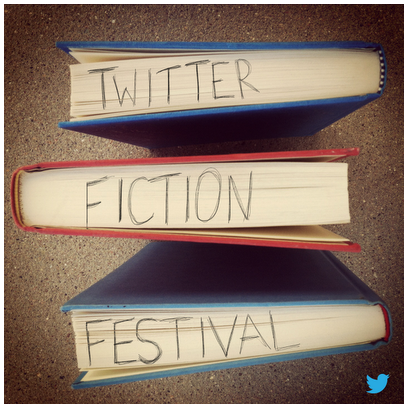 As November eases into December, and NaNoWriMo ends in delivery or defeat, there’s a new seasonal online writing event to act as a mini come-down from the demands of bashing out a novel in a month. And you don’t need to write 50,000 words: you only need 140 characters.
As November eases into December, and NaNoWriMo ends in delivery or defeat, there’s a new seasonal online writing event to act as a mini come-down from the demands of bashing out a novel in a month. And you don’t need to write 50,000 words: you only need 140 characters.
Wednesday 28th November 2012 sees the start of the first Twitter Fiction Festival! This is a five-day virtual storytelling celebration held entirely on Twitter between 28th November and 2nd December. It will feature creative experiments in storytelling from authors around the world. Everyone is invited to participate – just use the hashtag #twitterfiction and tell your own stories.
Twitter (says Twitter) is a “place to tell stories. Often those stories are about news or politics… but it turns out Twitter is a great place for telling fictional stories, too.” For those in the UK who have recently discovered that careless tweeting about news stories can result in litigious unpleasantness, focusing on fiction sounds a wise move. And there are precedents for it it the Twittersphere – such as Nick Berlades’s @smallplaces, the first literary Twitter novel, tweeted on Twitter.
I have often thought that Twitter as a medium is quite ‘writerly’ – forcing you to focus on getting your idea across in the most succinct, elegant, economic way: in 140 characters or fewer. Perfect for comics, poets and polemics – writers of all kinds. The Twitter Fiction Festival is way of celebrating Twitter as a literary practice.
Twitter has announced its Twitter Fiction Festival selections – an eclectic line-up of storytelling projects to showcase during the Festival. It has even set up a dedicated showcase page to highlight 29 participating writers, chosen from over 20 countries.
One of the chosen few is children’s author Lucy Coats (@lucycoats), who contributed to The Publishing Talk Guide to Twitter. Lucy will kick off the worldwide proceedings at 1.40pm in the UK on Wednesday by having her first tweet read out on BBC Radio 4′s World at One. She will be tweeting the whole of Atticus The Storyteller’s 100 Greek Myths as 100 x 140 character ‘tabloid headline’ tweets – 20 a day between 2pm – 3pm over the 5 days of the festival.
Telling stories in 140 characters has proved an intellectual challenge for me, as well as stretching my writing skills.
 Lucy tells Publishing Talk: “I hope the first Twitter Fiction Festival will encourage many other writers to experiment with something new. Telling stories in 140 characters has proved an intellectual challenge for me, as well as stretching my writing skills, and if I can successfully show ancient Greek myths in a way which will make people look at them as fresh and current, then I’ll have done my job. Crafting them in such a short form has certainly shown me that those long-ago godly shenanigans are perfectly suited to today’s tabloid headlines!”
Lucy tells Publishing Talk: “I hope the first Twitter Fiction Festival will encourage many other writers to experiment with something new. Telling stories in 140 characters has proved an intellectual challenge for me, as well as stretching my writing skills, and if I can successfully show ancient Greek myths in a way which will make people look at them as fresh and current, then I’ll have done my job. Crafting them in such a short form has certainly shown me that those long-ago godly shenanigans are perfectly suited to today’s tabloid headlines!”
Follow the Twitter Fiction Festival showcased writers at twitter.com/hashtag/twitterfiction – and join in yourself by using the hashtag #twitterfiction. See you there!
The Twitter Fiction Festival takes place between Weds 27 Nov – Sun 2nd Dec 2012.
Lucy Coats and Nick Berlardes are both contributors to The Publishing Talk Guide to Twitter.


Come down from #NaNoWriMo with #twitterfiction – the first Twitter Fiction Festival
 As November eases into December, and NaNoWriMo ends in delivery or defeat, there’s a new seasonal online writing event to act as a mini come-down from the demands of bashing out a novel in a month. And you don’t need to write 50,000 words: you only need 140 characters.
As November eases into December, and NaNoWriMo ends in delivery or defeat, there’s a new seasonal online writing event to act as a mini come-down from the demands of bashing out a novel in a month. And you don’t need to write 50,000 words: you only need 140 characters.
Wednesday 28th November 2012 sees the start of the first Twitter Fiction Festival! This is a five-day virtual storytelling celebration held entirely on Twitter between 28th November and 2nd December. It will feature creative experiments in storytelling from authors around the world. Everyone is invited to participate – just use the hashtag #twitterfiction and tell your own stories.
Twitter (says Twitter) is a “place to tell stories. Often those stories are about news or politics… but it turns out Twitter is a great place for telling fictional stories, too.” For those in the UK who have recently discovered that careless tweeting about news stories can result in litigious unpleasantness, focusing on fiction sounds a wise move. And there are precedents for it it the Twittersphere – such as Nick Berlades’s @smallplaces, the first literary Twitter novel, tweeted on Twitter.
I have often thought that Twitter as a medium is quite ‘writerly’ – forcing you to focus on getting your idea across in the most succinct, elegant, economic way: in 140 characters or fewer. Perfect for comics, poets and polemics – writers of all kinds. The Twitter Fiction Festival is way of celebrating Twitter as a literary practice.
Twitter has announced its Twitter Fiction Festival selections – an eclectic line-up of storytelling projects to showcase during the Festival. It has even set up a dedicated showcase page to highlight 29 participating writers, chosen from over 20 countries.
One of the chosen few is children’s author Lucy Coats (@lucycoats), who contributed to The Publishing Talk Guide to Twitter. Lucy will kick off the worldwide proceedings at 1.40pm in the UK on Wednesday by having her first tweet read out on BBC Radio 4′s World at One. She will be tweeting the whole of Atticus The Storyteller’s 100 Greek Myths as 100 x 140 character ‘tabloid headline’ tweets – 20 a day between 2pm – 3pm over the 5 days of the festival.
Telling stories in 140 characters has proved an intellectual challenge for me, as well as stretching my writing skills.
 Lucy tells Publishing Talk: “I hope the first Twitter Fiction Festival will encourage many other writers to experiment with something new. Telling stories in 140 characters has proved an intellectual challenge for me, as well as stretching my writing skills, and if I can successfully show ancient Greek myths in a way which will make people look at them as fresh and current, then I’ll have done my job. Crafting them in such a short form has certainly shown me that those long-ago godly shenanigans are perfectly suited to today’s tabloid headlines!”
Lucy tells Publishing Talk: “I hope the first Twitter Fiction Festival will encourage many other writers to experiment with something new. Telling stories in 140 characters has proved an intellectual challenge for me, as well as stretching my writing skills, and if I can successfully show ancient Greek myths in a way which will make people look at them as fresh and current, then I’ll have done my job. Crafting them in such a short form has certainly shown me that those long-ago godly shenanigans are perfectly suited to today’s tabloid headlines!”
Follow the Twitter Fiction Festival showcased writers at twitter.com/hashtag/twitterfiction – and join in yourself by using the hashtag #twitterfiction. See you there!
The Twitter Fiction Festival takes place between Weds 27 Nov – Sun 2nd Dec 2012.
Lucy Coats and Nick Berlardes are both contributors to The Publishing Talk Guide to Twitter.


November 22, 2012
Amazon tackles review problem, deletes wrong reviews
By Suw Charman-Anderson at forbes.com:
After the fake reviews furore of September died down, we were all left wondering what, if anything, Amazon was going to do. The notoriously tight-lipped company had said little about the issue of sock-puppet accounts, malicious one star reviews and self-serving fake five star reviews of books (and probably other stuff too). And publishers seemed to be so busy staring at their feet whilst singing ‘La la la la’ and jamming their fingers in their ears that they couldn’t find the wherewithal to comment either.
“So what next?” we asked, hoping that the issue wouldn’t simply dry up and blow away.
Well, those of us who thought that Amazon would do nothing were, it turns out, wrong. Amazon has, in fact, tweaked its customer reviews guidelines and has started deleting reviews. Except it might well be deleting the wrong reviews.
Continue reading at forbes.com.


#NaNoWriMo 30-day writing bootcamp (Week 4)
 Day 22: Draw your character – especially if you can’t draw.
Day 22: Draw your character – especially if you can’t draw.
Day 23: What does your character remember about being 10?
Day 24: Take your character out for a half-hour walk. Look at your neighbourhood with their eyes. What would they notice that you don’t? As soon as you get home, make notes.
Day 25: 12,500 words… imagine your character’s perfect idea of a holiday, especially if it’s different from yours.
Day 26: What does your character get really cross about? Write their rant.
Day 27: Include all five senses in your writing today – sight, smell, hearing, touch, taste. Add the sixth.
Day 28: The memory police are coming to wipe your character’s memories in five minutes time – what ones would he/she save?
Day 29: What’s the worst that can happen…? Write it.
Day 30: Woohooo! You have at least 15,000 words written but, more than that, you’ve kept going a daily writing practice. Suspend disbelief and write a dialogue between you and your work-in-progress. Ask it questions about what it needs from you now. Write down the answers. Keep writing until your WIP has finished talking.
Let us know how you get on – and find Sarah’s full 30-Day Writing Bootcamp in issue 03 of Publishing Talk Magazine, along with lots of other great articles and resources. The PDF edition is available free to mailing list subscribers until the end of November.



